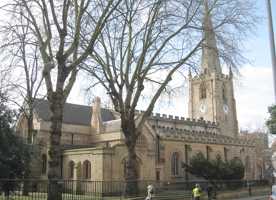For this church:    |
 NottinghamSt Peter with St JamesNottingham Archdeaconry Nottingham South Deanery IntroductionSt Peter’s Church, as it is always known, is one of the three mediaeval foundations in Nottingham, the others being St Mary’s (pre-Conquest) and St Nicholas’. The three ancient parishes cover the core of the city, which is largely non-residential. St Peter’s parish however also includes The Park, the 19th-century residential development in the former deer-park of Nottingham Castle. This was formerly the parish of St James’ Church, Standard Hill, founded in 1807; this benefice was united with St Peter’s in 1933, whence the present official title “St Peter with St James”. St James’ was demolished a few years later; some monuments from St James’ are preserved in St Peter’s. Since St Mary’s underwent substantial rebuilding in the 15th century, and St Nicholas’ is a late 17th-century building (following the demolition of the mediaeval church in the Civil War), St Peter’s has some claim to be the oldest building in the city to be in continuous use. The present building shows traces of many stages of construction from about 1180 onwards (the original church of around 1100 was destroyed by fire), right up to the present day. The church stands in the very centre of the modern city, near the Old Market Square and the Council House and surrounded by busy shopping streets, offices and other commercial activity. It is open seven days a week, and is seen as an oasis amid the city bustle and as a refuge from the pressures of the world. In consequence, it sees its ministry as being to the people of the city, especially the disadvantaged and disaffected - though it also has a strong Sunday congregation drawn from all over the city and beyond, and is the base for the Commercial Chaplaincy. In terms of its “style” it is liberal, middle-of-the-road in theology and liturgy, with a sense of acceptance and openness to all. There is also a strong musical tradition (with a good organ and a robed RSCM choir). Particular thanks to Peter Hoare for research on this entry |





